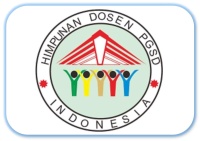Improvement Of Integrated Thematic Learning Outcomes With Contextual Teaching ApproachAnd Learning (CTL) In Class IV SDN 11 Aur Kuning
Abstract
The purpose of this study is to improve students' integrated thematic learning outcomes using a contextual teaching and learning approach. Integrated thematic learning is one of learning that combines several subjects into one theme. integrated thematic learning also links learning with students' daily lives and integrated thematic learning can also make the learning process more meaningful, efficient and effective. This research method, using classroom action research methods. The research procedure is in the form of a cycle. Each cycle consists of three stages: planning, implementing actions, observing, and reflecting. Data collection technique through observation and test.This data collection uses instruments in the form of observation sheets of student and teacher observations in the learning process, then to find out the quality of student learning outcomes used evaluation sheets / tests. The results of the study indicate that the use of contextual teaching and learning approaches can improve student integrated thematic learning outcomes. From an average value of73.07 in the first cycle, to 85.15 in the second cycle
Keywords
References
Arikunto, Suharsimi. 2007. Dasar dasar Evaluasi Pendidikan. Jakarta : PT Bumi Aksara
Penelitian Tindakan Kelas. Jakarta: Bumi Aksara.
Desyandri. (2012). The Usage of Contextual Teaching and Learning (CTL) Approach to improve the process and learning outcome of Singing to the Student Class III Elementary School YPKK of Padang State University. Pedagogi: Jurnal Ilmu Pendidikan, 12(1), 36–52. Retrieved from http://pedagogi.ppj.unp.ac.id/index.php/pedagogi/article/view/231
Desyandri, D., & Vernanda. (2017). Pengembangan Bahan Ajar Tematik Terpadu di Kelas V Sekolah Dasar Menggunakan Identifikasi Masalah. In Seminar Nasional HDPGSDI Wilayah 4 (pp. 163–174). Ambon. Retrieved from https://ejournal.unpatti.ac.id/ppr_paperinfo_lnk.php?id=1720
Kemendikbud. 2016. Panduan Penilaian untuk Sekolah Dasar (SD). Jakarta: Kemendikbud.
Kunandar.2008. Langkah Mudah Penelitian Tindakan Kelas sebagai Pengembangan Profesi Guru.Jakarta : Rajawali Pers
Majid, Abdul. 2014. Pembelajaran Tematik Terpadu. Bandung: PT Remaja Rosdakarya
Musriliani1, C., Marwan, & Anshari, I.B. 2015.Pengaruh Pembelajaran Contextual Teaching Learning (CTL) terhadap Kemampuan Koneksi Matematis Siswa SMP Ditinjau dari Gender. Jurnal Didaktik Matematika, 2(2), 1-10.Sanjaya ,Wina. 2006. Pembelajaran dalam implementasi kurikulum berbasis kompetensi. Kencana : Jakarta
Trianto.(2014). Model-Model Pembelajaran Inovarif.Jakarta: Kencana Group
Miaz,Yavelma.2014. Penelitian Tindakan Kelas Bagi Guru Dan Dosen.:UNP Press Padang
Sugiyono. 2014. Metode Penelitian Pendidikan Pendekatan Kuantitatif,Kualitatif, dan R & D. Alfabeta: Bandung.
Sukardi. 2010. Metodologi Penelitian Pendidikan. Jakarta: Bumi Aksara
Susanto, Ahmad. 2012 Teori Belajar dan Pembelajaran di Sekolah Dasar.Jakarta: Kencana Prenada Media Group
DOI: http://dx.doi.org/10.24036/e-jipsd.v7i12.7434


